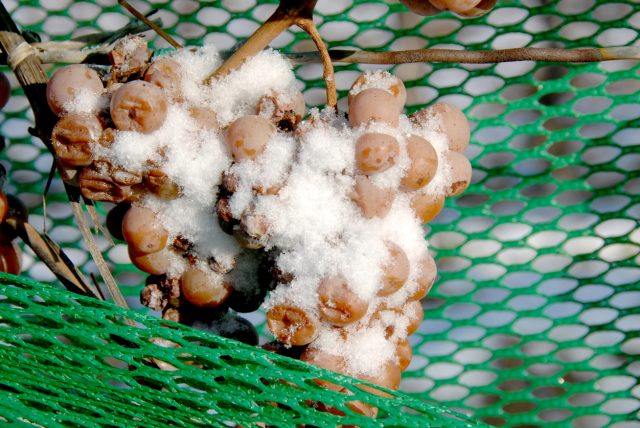Ice Wines To Enjoy This Season!

With the majority of wines, harvest season typically falls between August & October in the Northern Hemisphere and February & April in the Southern Hemisphere… Making ICE WINE a wonder in itself!
These grapes brave the freezing temperatures in winter and make for some incredibly delicious vino.
Here’s All You Need To Know About Ice Wine:
Ice wine is a very sweet wine that’s often served with dessert or at the end of a meal. It’s made from grapes that have frozen on the vine, which happens with air temperatures of 17.6 degrees. Working quickly so that the grapes don’t have time to thaw, winemakers pick and press the grapes while they’re still frozen. Only the highly concentrated juice is pressed from the frozen berries, leaving behind the icy water crystals and producing an intensely flavored product.
It’s been supposed that in Franken, Germany, during a particularly cold winter in 1794, winemakers were forced to create a product from the grapes available for harvest. The resulting wines from that vintage had an amazingly high sugar content, along with great flavor. Thus, the technique became popularized in Germany. By the mid-1800s, the Rheingau region was making what the Germans called eiswein.
The Making Of Ice Wine:
The secret to ice wine is processing frozen grapes at around 20 ºF (-7º C). Frozen grapes are picked frozen on the vine and come into the winery.
Imagine thousands of hard, icy marbles dropping into grape crusher and grape press. Ouch! Many heritage presses break under the pressure of squeezing frozen grapes!
At any rate, only about 10–20% of the liquid in these frozen grapes is used for ice wine. The juice is so sweet (anywhere from ~32–46 Brix), that it can take anywhere from 3–6 months to make ice wine. (This is a long, slow, finicky fermentation!)
When it’s all done, wines have around 10% ABV and a range of sweetness from around 160–220 g/L of residual sugar. 220 g/L is two times the sweetness of a Coke!
All About The Grapes:
The grapes that grow well in cold climates make the best ice wines and these include: Cabernet Franc, Merlot, Gewürztraminer, Riesling, Grüner Veltliner, Chenin Blanc, and Vidal Blanc. Cabernet Franc stuns with its brilliant orange-ruby hue, but it’s hard to find outside of Ontario, Canada.
True Ice Wine
True ice wine requires a cold climate where grapes are harvested frozen on the vine. Fortunately, in Canada, Germany, Austria, and the US, dessert wines are not allowed to be labeled as ice wine if grapes are commercially frozen. You will see these products usually labeled as “iced wine” or simply “dessert wine.” So, if you’re looking for true ice wine, be a wary shopper and read the labels or look up the production information.
Pairing Food With Ice Wine:
True ice wine requires a cold climate where grapes are harvested frozen on the vine. Fortunately, in Canada, Germany, Austria, and the US, dessert wines are not allowed to be labeled as ice wine if grapes are commercially frozen. You will see these products usually labeled as “iced wine” or simply “dessert wine.” So, if you’re looking for true ice wine, be a wary shopper and read the labels or look up the production information.
Aging Ice Wine:
Most people believe ice wines can age only about 10 years, but certain varieties (Riesling and Grüner Veltliner) age longer.
Still, if you love the tingle of acidity in an ice wine, don’t plan on aging it too long. That sparkle diminishes over time to reveal a syrupy, rich, deep bronze-colored wine. Expect flavors of molasses, maple, and hazelnut in an ice wine aged long term.

